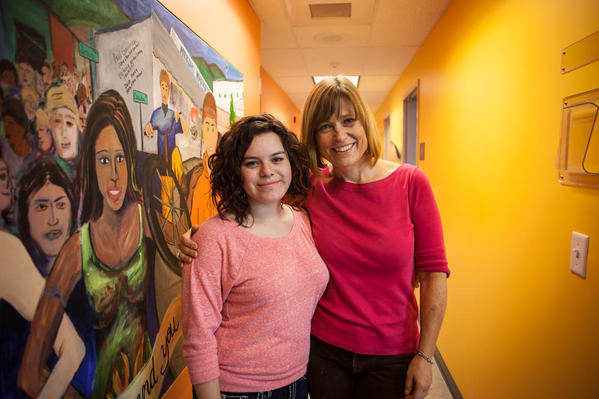When students show up for an appointment at the Elsie Allen Health Center, which is located on the Elsie Allen High School campus in Santa Rosa, CA, one of the first things they do is take an ACE survey. Instead of answering the 10-question survey developed for the CDC-Kaiser Permanente Adverse Childhood Experiences Study (ACE Study), they respond to 16 questions.
That’s because the questionnaire was designed by the clinic staff to address the kinds of experiences – such as homelessness and pregnancy – that are common in their students.
Seventy percent of the students at Elsie Allen High School are Latino, and most of their parents work in low-income jobs. Most of the school’s 1,100 students are covered by insurance and Medical, and there is a sliding scale for older teens. The clinic is part of Santa Rosa Community Health Centers.
Erin Moilanen, a family nurse practitioner, is one of the core staff, which also includes two therapists, a pediatrician, and a physician assistant. The ACEs screening started a year and a half ago when Kaiser Permanente Northern California Region awarded the clinic a $50,000 grant to do trauma-informed care.
“We started with a six-question questionnaire called the Childhood Traumatic Events Scale, but we realized it didn’t cover a lot of traumatic experiences, and it didn’t ask specific questions. The kids are very concrete, and some didn’t even understand what trauma meant,” says Moilanen.
The result was that in the second year of the program – which was funded again with $50,000 from Kaiser – the staff modified the questionnaire to include 16 questions relevant to the experiences of the students they had seen the first year. (See attached questionnaire.) The extra questions were added by the therapists and providers based on what they heard the kids report over and over again.
Moilanen says that 20 students per day come into the clinic, but typically only between one and 3 of the students are new. They are screened on their first appointment, and then yearly. A therapist explains the ACEs form to them and why it is important: “Difficult things that happen to us can affect our choices and our health in the future.”
The kids get it, she says. Responses include “a lot of head nodding in agreement, looks of dawning understanding, and some ‘yeahs.’”
Explaining ACEs to the students, Moilanen offers her approach. “So I say something like, ‘We, the medical community, now know that when difficult things happen to us when we’re young, it can actually affect our health in the future, so we’re trying to ask kids when they’re younger to try to prevent some of the bad things from happening and help them have healthier lives.”
She adds, “I feel that the kids answer honestly. We all like to talk about ourselves, and a lot of these kids don’t have people who are listening to them,” she says. The ACEs screen has had greater impact on her work than any other screening done in the clinic used in the past, such as screens for STDs or dental health, she says, because it helps develop better relationships with the students.
Last year, only 200 students were screened because of construction issues that kept the clinic closed for a few months. This year, Moilanen says, they’ve had far more new patients since they were open during the summer. They have neither the time nor the money to analyze the screening data, which they have turned over to Kaiser.
As a result of the ACEs screening, however, the entire staff is “a bit more understanding about some of the behaviors of the kids. And I think we encourage counseling a lot more than we ever did before,” says Moilanen. The staff has also done their own ACE scores and talked about handling vicarious trauma. Information for staff counseling is posted throughout the clinic as a result.
“There’s a different level of honesty and connection with the kids,” adds Moilanen, who trained, along with the other grantee staff, at Kaiser workshops on trauma-informed care. “It feels like it’s going to make a bigger impact. Thinking back to my own experiences as a teen, it’s far more important to talk about these experiences earlier and prevent negative results from happening in the future.”
The clinic is just starting to get the school itself involved by getting permission to speak to the teachers about ACEs. Additionally, the clinic is turning a large room into a lounge area for the 100 or so students who visit the clinic each day so they’ll have a place to talk, get a free condom, cough drop (because teachers are nervous about whooping cough scares when children cough) or piece of fruit, and to share their experiences. |
Customizing ACEs Screening for High School Students in Santa Rosa, CA
Attachments
Files (1)


Comments (4)